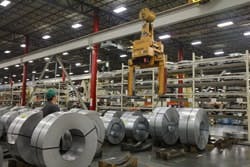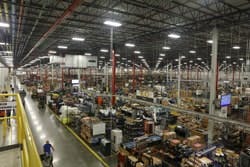Global manufacturing operations face unique challenges when it comes to improving systemwide operational efficiency. With personnel scattered across numerous domestic and international sites, there’s a broad knowledge base to call on, to be sure, but the use of different suppliers and products and different plant configurations at each location can make it difficult to identify, let alone implement to scale, production best practices.
That’s the issue that Whirlpool Corp., with 97,000 employees and some 70 manufacturing and technology research centers worldwide, has worked to tackle with its Advanced Manufacturing organization. The AM organization, according to the company, “provides research, process technical guidance, and new process technology development” to Whirlpool’s businesses in North America, South America, Europe, and Asia.
“It’s really the only global manufacturing team that Whirlpool Corporation has,” says Mike Anthony, director of Advanced Manufacturing at the company, which records approximately $21 billion in annual sales. “A lot of the manufacturing decisions and how we approach the market are very regional in nature, and that’s for a reason – so (we) can be close to the consumers.” Still, the company wants to be able to understand and leverage efficiency opportunities at individual sites or in a given region as well as identify and address any more-widespread issues, and that’s where the AM team comes in.
The organization is charged with three main tasks, Anthony says. First, “we have responsibility for developing process technologies that enable manufacturing and product leadership,” he says. Next, “we ensure we have common manufacturing processes and manufacturing approaches across the world,” Anthony continues. “We have the opportunity to see multiple plants (and) leverage best practices between plants and have the chance to see if there are issues globally.”
Finally, the team works to resolve knowledge gaps. “If there is an issue with how we make something,” Anthony says, “it’s our role to go out and either partner with universities, partner with external suppliers, (and/or) develop pilot programs to try to resolve manufacturing gaps.”
The second and third tasks led the AM organization last year to identify latent capacity in the cabinet foaming area of its refrigerator assembly process. As Anthony describes it, “Traffic flow management of getting our refrigeration products into and out of our foam process system varied greatly around the world – it varied by region, by plant footprint, by supply phase.”
He adds: “We noticed different performance rates out of different suppliers as well as how the plants are configured. Almost all our facilities aren’t greenfield – we don’t have a chance to start over. We have to fit things in where they can fit, mostly.”
[sidebar id="5"]
The solution? Simulation modeling – testing tweaks to processes and configurations based on plants’ unique footprints to find out how small changes could have a significant impact on throughput.
“We thought, ‘How can we prove what is the best approach?’ “ he says. “We thought simulating it would be the best way.”
Effective simulation would call not just for advanced technology to power the simulation models themselves but also business and engineering expertise to make sense of the results and evaluate the feasibility of possible line changes. At this point, Anthony and the AM team – recognizing their third task of resolving knowledge gaps – turned for assistance to a graduate student team from the University of Michigan’s Tauber Institute for Global Operations. The two-person student team consisted of John Klocke, an MBA candidate, and Nick Walker, a member of the university’s Engineering Global Leadership Honors program pursuing BSE and MSE degrees in chemical engineering, as well as faculty adviser Brian Talbot.
Based on-site with Whirlpool Corp. in St. Joseph, MI, last summer, the student team used ProModel computer simulation software to develop current-state models of cabinet foam lines in the company’s Amana, Iowa, and Joinville, Brazil, locations – the latter being Whirlpool’s largest in the world, according to Anthony. The students also traveled to both locations and to a Whirlpool Corp. site in Ottawa, OH, and interviewed local subject-matter experts, finance leads, and engineers. It was “lots of interaction and face time with the plant … to understand not only how the (refrigeration assembly) process works but also all the costs and indirect costs associated with it,” he says.
So while software enabled the development of sophisticated simulation models, local expertise allowed for the input of real-world, from-the-floor insights to enhance decision-making. The Tauber Institute team and company employees analyzed timing, changeover, and production scheduling data for assembly lines at each site and then created future-state models incorporating equipment layout changes that would still fit within each plant’s configuration.
“Through the use of the simulation at a very detailed level … we were able to find where we needed to alter pieces of equipment, where we needed to alter programming, where we needed to learn how to (move) components into the system differently,” Anthony says. Students Klocke and Walker demonstrated that placing two additional sensors on critical equipment and altering timing logic could increase capacity 23% – about 6,000 to 10,000 units per year.
The future-state models that the students developed will guide Whirlpool Corp.’s efforts to implement best-practice cabinet foaming processes in 50 lines worldwide, and the work “will ultimately provide multimillion-dollar benefits to Whirlpool,” said faculty adviser Talbot in a release from the Tauber Institute.
The corporation now is able to prove that by revising two or three pieces of equipment, revising conveyor belts, and altering sequences slightly, throughput can increase by double-digit percentages, Anthony says. “The reason this is important,” he adds, is you’re able to release latent capacities that we have in our facilities that otherwise we’d spend millions of dollars to fix.”
And the benefits go beyond identifying opportunities to improve current layouts, equipment, and processes. As the company looks forward, it’s relying on simulation to inform buying decisions and operational plans. Site teams now “realize that the investment into working on a simulation package is almost mandatory” before new equipment is purchased or line changes are made, Anthony says. “I think everybody kind of knew about (simulation) in the past and everybody said, ‘Yeah, it’s a toy, it helps.’ But this program helped prove that the return was 100-fold.”
“Almost all our facilities aren’t greenfield – we don’t have a chance to start over,” says Whirlpool’s Mike Anthony. “We have to fit things in where they can fit, mostly.” That’s where computer simulation comes to the rescue.
For a global manufacturing business like Whirlpool (pictured is a facility in Cleveland, TN), implementing production-line best practices poses numerous challenges stemming from varying plant layouts and the use of different regional suppliers.




